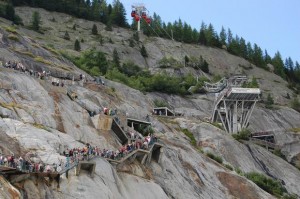After what France is describing as the ‘climatic disaster of 2015’ – a hot summer – Prime Minister Manuel Valls and his eco minister Ségolène Royal visited Chamonix last week to hear the town’s complaints about its air pollution and while there have a look at the Mer de Glace, France’s largest but rapidly shrinking glacier. Having slogged much further up the mountain than would have been necessary not long ago, Valls made the usual remarks about climate change laid bare and took the opportunity to declare war on warming: ‘une mobilisation générale’ ahead of the Paris climate conference in December – COP 21. This ugly name reminds us that there have been many of these conferences before, and many bold declarations of intent. As Valls pointed out, the forces behind warming are working much faster and more effectively than our efforts to combat them.
The retreat of the glaciers is so obvious and rapid, we do not need long memories to notice the change as we toil up the long staircase from the end of the Vallée Blanche to the telecabine which was itself installed half a century ago to bridge the gap that had opened between Montenvers station and the ice below.
Yet the inferences we should draw are less clear. The Alpine glaciers have been in retreat for nearly two hundred years, since the so-called ‘little ice age’ came to an end in about 1830 by which time Chamonix’s four great glaciers had all reached the valley floor, having crushed Bonanay and other villages unlucky enough to get in the way. We can hardly attribute this long process entirely to man’s malign influence. Within it there have been pauses, changes of pace, and even reverses, quite recently, when the glaciers have grown back a bit. Their ebb and flow reflects the interplay between winter and summer, precipitation and temperature. Warmer does not necessarily mean drier.
Be that as it may, climate change and glacier loss have already had a big impact on the ski business. The migration of skiers from low to high resorts starves the former of funds to invest in snow-making and lift improvements, so they fall further behind in the expensive upgrading race and become increasingly uncompetitive in the marketplace. Ski areas in the Jura and the Vosges operate for a few weeks a year. When the operating licence runs out, and rusty lift pylons need replacing, is it worth it? Praise be for mountain biking, which keeps the chair lifts busy in summer.
Meanwhile, resorts fortunate enough to have glacier ski areas face the problem that lift stations sited on rocky outcrops conveniently surrounded by ‘eternal snow,’ as it is always termed, now find themselves separated from the piste by a cliff or a yawning crevasse.

Andermatt’s Gurschengletscher lost 20 metres in 15 years, requiring the creation of a snow ramp with a protective blanket
In 2005 Andermatt was the first resort to experiment with a system of covering snow with a protective blanket to keep it cool in summer. This may be a fine illustration of the sticking plaster approach but it has worked well, and the carpet’s manufacturer Landolt is one of many companies doing well out of warming. Laax now rolls out 25,000 sq metres of carpet, equivalent to three football pitches, as a sunscreen for its glacier from May to September.
A few metres shy of 3000m, Mürren’s rotating-restaurant-capped summit the Schilthorn does not do glacier, but a few patches of snow usually survive the summer and according to the lift company the chance to touch snow is an absolute priority for many summer visitors from far-off places. So here too the techno-blanket is deployed to preserve the precious commodity. Pitztal and Hintertux are among the Austrian ski resorts that prefer the alternative approach of installing snow-making machines on the glacier.
Argentière has also had success with the blanket method of accumulating a bank of snow with which to plug the widening gap at the top of the Point de Vue piste. For those who prefer to turn right at the foot of the staircase, photographs of the state of the glacier at the end of this summer and last convey a stark message: be careful before venturing down the front face this winter. How long before this exciting variant joins Eismeer and other Alpine classics on the list of runs that are no longer skiable?
A friend who organises summer and autumn ski race training camps tells me he is giving up on the Alps after the difficult summer of 2015, and will in future hold his camps in Norway where the glaciers are in much better shape.





